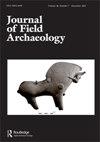Long Bones and Antlers for Artifact Production in the Final Late Bronze Age Settlement of Thessaloniki Toumba (Northern Greece, 1210–1040 cal b.c.)
IF 1.5
1区 历史学
0 ARCHAEOLOGY
引用次数: 0
Abstract
ABSTRACT We present two significant patterns of osseous artifact production during the Final Late Bronze Age at the settlement mound of Thessaloniki Toumba in the northeastern Thermaic Gulf region in northern Greece and compare with data published from the same and neighboring regions. One pattern is the use of long bone fractures for shaping awls. The other is the production of pins from deer antlers. Awl manufacturing is consistent with the practice of the use of broken bones for a variety of tools, which had been common since the Early Bronze Age. The antler pins and some rare, elaborate objects, such as barbed-and-tanged points and horse bits, indicate innovation and interactions across different spatial scales toward the end of the Bronze Age. Research into the manufacturing processes may provide a more detailed understanding of the cultural and technological significance of these artifacts.青铜时代晚期塞萨洛尼基-图姆巴(希腊北部,公元前1210年至1040年)最后一处定居点的长骨和鹿角
摘要:我们在希腊北部热姆湾东北部地区的塞萨洛尼基-图姆巴定居点,提出了青铜时代晚期最后一个时期两种重要的骨制品生产模式,并与同一地区和邻近地区的数据进行了比较。一种模式是使用长骨骨折来塑造锥子。另一种是用鹿角制作大头针。锥子制造与使用骨折制作各种工具的做法一致,这种做法自青铜时代早期以来就很常见。鹿角针和一些罕见的、精致的物体,如有刺的、有尖刺的尖端和马尖,表明青铜时代末期不同空间尺度上的创新和互动。对制造过程的研究可以更详细地了解这些文物的文化和技术意义。
本文章由计算机程序翻译,如有差异,请以英文原文为准。
求助全文
约1分钟内获得全文
求助全文
来源期刊

JOURNAL OF FIELD ARCHAEOLOGY
ARCHAEOLOGY-
CiteScore
4.60
自引率
5.30%
发文量
29
期刊介绍:
The Journal of Field Archaeology is an international, refereed journal serving the interests of archaeologists, anthropologists, historians, scientists, and others concerned with the recovery and interpretation of archaeological data. Its scope is worldwide and is not confined to any particular time period. Contributions in English are welcomed from all countries.
 求助内容:
求助内容: 应助结果提醒方式:
应助结果提醒方式:


